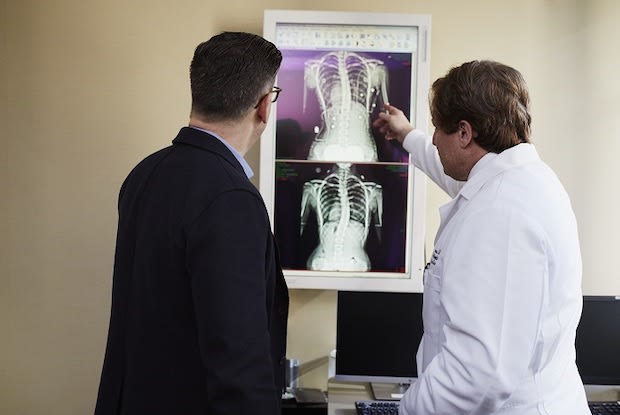Table of Contents
IV. Determine Any Underlying Causes
e. Other heart rhythm medications
d. Implantable cardioverter-defibrillator (ICD)
e. Left atrial appendage closure
Diagnosis
The first step in your treatment protocol is to first get a diagnosis for your heart condition from a medical professional. If your pulse feels fast and you are experiencing chest pain or discomfort, your doctor may check you for atrial fibrillation (AFib).
Your doctor may ask questions including:
- How long have you had symptoms? Describe them.
- Do you have other medical conditions?
- How much alcohol do you consume?
- Is there a family history of AFib or other heart-related conditions?
- Do you have heart disease or a thyroid condition? [1]
Diagnostic Tests

To diagnose atrial fibrillation, your doctor may order certain kinds of tests to examine your condition. Common AFib tests include:
Electrocardiogram (ECG)
An ECG is the primary tool used to diagnose AFib. This test uses small electrodes attached to your chest, arms, and legs to record the electrical signals and rhythm of your heart. The test is short, around five minutes in length, and painless. It can be challenging to record AFib in a short amount of time. Therefore you may be asked to wear a portable ECG recorder for 24 hours.
Echocardiogram
An echocardiogram is an ultrasound scan of the heart used to determine if there are any blood clots or signs of heart disease. It assesses the structure and function of the valves and vessels of the heart.
Chest X-ray
An x-ray is used to see the condition of the lungs. Sometimes problems with the lungs may cause AFib. X-ray is used to identify any other conditions that may explain the signs and symptoms you are experiencing.
Blood tests
A blood test can pick up on problems with kidney function and the thyroid gland, as well as anemia; these conditions can contribute to AFib. [2]
Treatment
Treatment for AFib can include lifestyle factors, such as exercise and a healthy diet, medicines to control heart rate, and surgical procedures when necessary.
Depending on the severity of your condition, it may be possible for your family doctor (GP) to treat you. Your GP may decide to refer you to a specialized cardiologist, called an electrophysiologist, who specializes in heart rhythm disorders. There are a handful of factors taken into account prior to determining which treatment plan is suitable for you.
Factors to consider before treatment include:
- Age
- Current overall health status
- Type of AFib you have
- Symptoms
- If there is another condition or underlying cause that also needs to be treated [2]
Determine Any Underlying Causes
The last bullet point above talking about underlying causes is important to consider. Sometimes treating an underlying cause may subsequently cure AFib. For example, if the doctor discovers you have hyperthyroidism (overactive thyroid gland), the medicine used to treat this condition can also treat and cure AFib. Make sure to inform your doctor of your family history, any pre-existing conditions, and all the symptoms you are experiencing. If there are no underlying causes for your AFib, medications and/or procedures may be considered by your doctor.
Medicines
Your doctor will likely choose medication as the first step in your treatment protocol. There is a selection of different acting medications that may be used to treat AFib, depending on the type that you have. Generally, there are three approaches to treatment: prevention of blood clots, heart rate control, or heart rhythm control. Different medications and procedures will act in different ways, either to control rhythm or rate in order to properly treat AFib type.
Blood thinners are widely known to help prevent blood clots and stroke. The two different kinds of blood thinners are anticoagulant and antiplatelet medications. If you are not at risk for a stroke, blood-thinning medication may not be necessary. The side effects of blood-thinners may include a higher risk of bleeding events, indigestion, and potential heart attack risk. Common blood thinners include: Digitalis and digoxin belong to a class of drugs called cardiac glycosides that are derived from the same plant, the foxglove. These two drugs help to restore the natural rhythm of the heart and prevent abnormal or irregular heartbeats. Generic drug brand names are Crystodigin for digitalis and Lanoxin for digoxin. The drugs work to control the heart rate. Beta-blockers function by slowing the heart rate. Specifically, this type of drug slows the rate that the heart’s ventricles (lower two chambers) pump blood throughout the entire body. The slowing-action of the ventricles allows them enough time to fill with blood properly. It's important to note that this approach is not necessarily a cure since the abnormal heart rhythm does continue while taking this drug; it can also make certain conditions worse, such as COPD and arrhythmia. But, beta-blockers may allow you to feel better and experience fewer symptoms. Common beta-blockers include: Similar to beta-blockers, calcium channel blockers function by helping to slow the heart rate. Specifically, calcium channel blockers help to normalize the ventricles. This drug controls the rate that the ventricles (lower chambers) pump blood throughout the body. Common calcium channel blockers include: Your doctor may prescribe medications other than the ones listed above to control for heart rhythm, as opposed to heart rate. Heart rhythm medications are recommended for those who may not see improvements with heart rate control medicines or for those who still have symptoms. For people who are very physically active or who have just recently started having AFib symptoms, heart rhythm control medicines are often used. It is not uncommon for doctors to prescribe heart rhythm medications alongside procedures such as electrical cardioversion. Common rhythm control medications include: If the combination of lifestyle changes and medication did not improve your symptoms, your doctor might recommend the next step be a medical procedure or surgery. Because heart surgeries come with risks, your doctor may likely consider a procedure only if you are already undergoing surgery for another heart condition. Different procedures used to treat AFib include: Cardioversion therapy is similar to defibrillation (controlled electric shock) but uses less electricity. If medicines have not worked, cardioversion provides low-energy shocks to the heart to restore its rhythm. Catheter ablation is a procedure that aims to destroy the heart tissue that is causing arrhythmia. In this procedure, electrophysiological testing is done to determine the location of the irregular impulses in the heart. Once the irregular impulse site is located, catheter ablation is then performed. Ablation involves creating tiny burns to destroy the electrically chaotic tissue; this creates scars that stabilize the heart’s electrical circuit. Ablation is not always successful and may cause complications such as stroke, especially within the first few weeks after the procedure. The British Heart Foundation has an informative video explaining what to expect during a catheter ablation procedure. Watch below. A pacemaker is a surgically implanted battery-operated device that uses electrical impulses to encourage a normal heartbeat and rhythm. The function of a pacemaker is to reduce AFib when it is triggered. The function of an ICD is to treat AFib that can lead to cardiac arrest. An ICD can be used to treat life-threatening heart rhythms by giving your heart a direct shock. This device may also be used as a pacing function to bring a slow heart rate back into the normal range. [3] If you are unable to take certain blood-thinning medications and are at an increased risk for stroke, left atrial appendage closure may be recommended. The left atrial appendage (LAA) is a small pouch that sits off of the left side of your heart. AFib may cause the blood being pumped through your heart to pool in the LAA, where it gets stuck and can form a clot, increasing stroke risk. During the left atrial appendage closure procedure, a catheter is inserted through a vein in a limb and is guided to the left atria (upper chamber) of the heart. A device is then inserted to close off a portion of the LAA, reducing the risk of blood clots. Before or in combination with medications and surgery, your doctor may recommend certain lifestyle changes to help with your AFib condition. A healthy lifestyle can reduce your risk of having a stroke. Lifestyle recommendations may include: Eating a healthy diet: A nutrient-dense diet high in fiber is essential for optimal health. Plant-based sources of food, such as fruits, vegetables, and legumes, are an amazing way to stay healthy, maintain healthy body weight, reduce cholesterol, and improve overall health. Reduce hidden sources of refined sugar and avoid eating processed, fast-foods whenever you can. Physical activity: Activities such as walking, biking, swimming, and yoga, are beneficial to add to your life. For healthy adults, at least 150 minutes of moderate aerobic activity is recommended per week. Limit or avoid alcohol and other stimulant intake: Alcohol and stimulants can increase your heart rate and trigger AFib symptoms. Minimizing your intake of alcohol and caffeine is recommended, so you can avoid triggering AFib. Other lifestyle recommendations include: There are free online resources that can provide you with helpful information on how to manage AFib. The British Heart Foundation has an easily-downloadable information booklet designed for people with AFib. The National Heart, Lung, and Blood Institute is another great resource that has a free booklet available online. The booklet is an action plan with practical tips about maintaining a heart-healthy lifestyle. The content in this article is intended for informational purposes only. This website does not provide medical advice. In all circumstances, you should always seek the advice of your physician and/or other qualified health professionals(s) for drug, medical condition, or treatment advice. The content provided on this website is not a substitute for professional medical advice, diagnosis or treatment.
Blood-thinning medications
Digitalis or digoxin
Beta-blockers
Calcium channel blockers
Other heart rhythm medications
Procedures or Surgery

Electrical cardioversion
Catheter ablation
Implantable pacemaker
Implantable cardioverter-defibrillator (ICD)
Left atrial appendage closure
Lifestyle Recommendations

